Options
Early numismatic Christmas present to myself. Also some questions on Assayer Initials on Ferdinand V
 TwoKopeiki
Posts: 9,854 ✭✭✭✭✭
TwoKopeiki
Posts: 9,854 ✭✭✭✭✭
Haven't seen this type come-up for auction in the last 5-6 years, so decided to pick it up if nobody else entered the bidding. Calbeto simply lists it as very rare with 1 to 5 known examples. Krause (and all sites using NumisMaster) has it for moon money and only up to VF. Heritage doesn't have a recorded sale of this type in their online archives.
It's an 1814/3 Mexico 8 Reales. What makes it a very rare piece are the assayer initials HJ (Henrique B. Azorin + Joaquin Davila Madrid), instead of the common JJ (Joaquin Davila Madrid + Jose Garcia Ansaldo).
I hope the catalog images are accurate and it has that gray original skin. I'll post my own shots once it arrives.
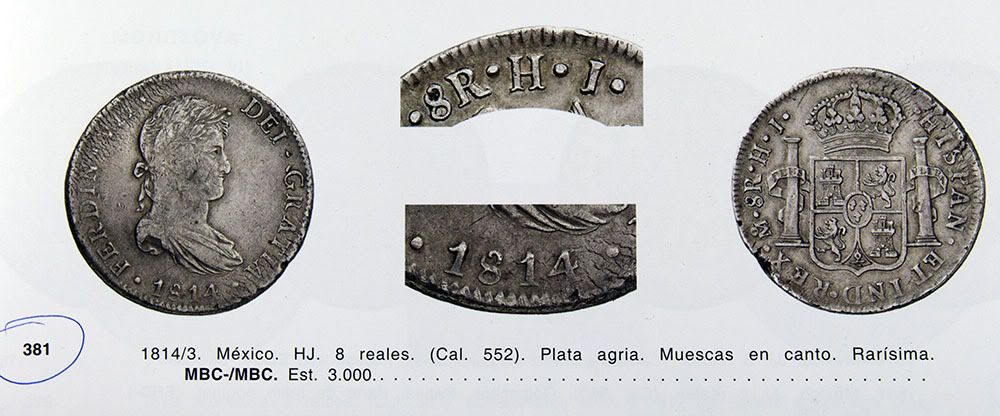
Update December 15th
The coin is now in my hands and I'm very pleased with it. I was pretty nervous about Aureo pictures, having received quite a few cleaned pieces that looked problem-free in their auction catalog in the past. Looks like a nice XF40-VF35. Nothing is raising red flags in terms of authenticity. 26.78 grams and properly edged.
Overdate 4/3 is weak, but you can see it under magnification (see image below). Researching information about this coin I saw that Calbeto mentions an 1814 HJ without an overdate in his Compendium, but lacks a plate coin for it. I was not able to find a reference to it in any other material. All the information points to 1814 HJ
having a 4/3 overdate, which makes me wonder if the HJ die pair only had one obverse die, which was recut from the previous year. Since I've only been playing in this field for a few years, I'm hoping somebody more experienced can chime in on this.
Without having more examples of the 1814 year it's hard for me to put together a comprehensive picture of the dies used, but my assumption based on the scarcity of the different assayer combinations makes me think that it was somehing along the lines of the production starting with the recut 1814/3 die and HJ reverse. Shortly afterwards the HJ die was replaced with a JJ (are there any JJ/HJ coins out there?), keeping the same 1814/3 obverse die (going to see if I can find clear examples of this die to confirm it was the same one), then changing the 1814/3 to 1814 die.
Taking one more step back, what's with multiple assayers on Mexico City coins from 1812-1814? Both HJ(Henrique B. Azorin + Joaquin Davila Madrid) and JJ(Joaquin Davila Madrid + Jose Garcia Ansaldo) assayer initials can be found on coins of that period. And if you look at the Armored Bust series you see similar things happening with the TH and HJ assayers.
Looking at the Ferdinand VII coinage of 1808 to 1821 from Mexico City Mint we have:
1808 --- TH
1809 --- TH
1809 --- HJ/TH
1809 --- HJ
1809/8 --- TH
(possible there is 1809/8 HJ/TH?)
1810/09 --- HJ
1810 --- HJ/TH
1810 --- TH
1810 --- HJ
(what about 1810/09 HJ/TH?)
1811/0 --- HJ
1811 --- HJ
1811 --- HJ/TH
(what about 1811/0 HJ/TH?)
1812 --- HJ
1812 --- JJ/HJ
1812 --- JJ
(any overdates this year?)
1813 --- HJ
1813 --- JJ
(any overdates and over-assayers?)
1814/3 --- HJ <--- Last time HJ die is used
1814/3 --- JJ
1814 --- JJ
(was the HJ die recut? if so, are there JJ/HJ for both 1814/3 and 1814 obverse dies?)
1815/4 --- JJ
1815 --- JJ
1816/5 --- JJ
1816 --- JJ
1817 --- JJ
1818 --- JJ
1819 --- JJ
1820 --- JJ
1821 --- JJ
Very interesting series to study.
Almost forgot - here's the coin
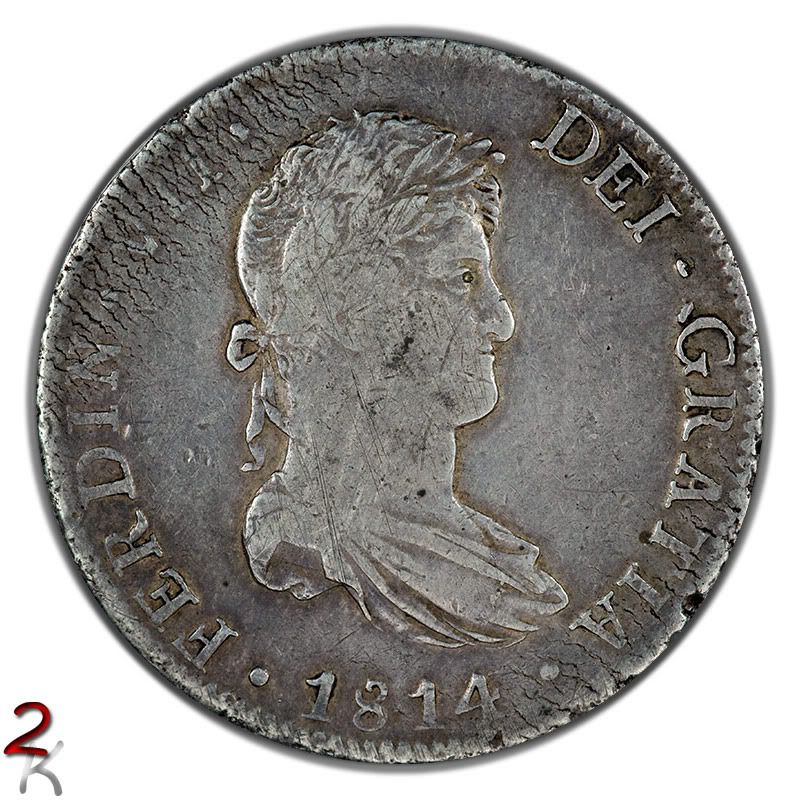

I had to play with lighting and contrast to make the overdate obvious in the photos.
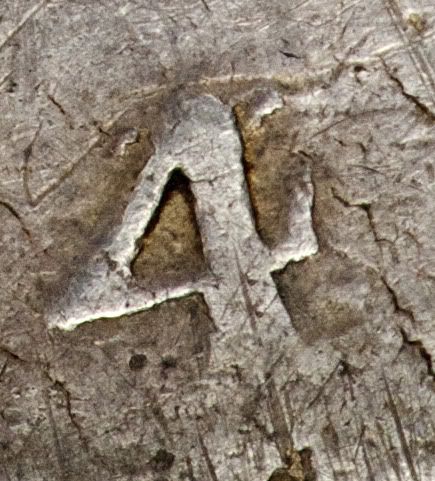
Update as of May 7th, 2017:
So, after the Sedwick sale, i followed-up with Kent Ponterio and we've settled on the price for another 1814/3-HJ they were selling as part of a large 8 Reales collection that I was able to preview at NYINC. Once the coin is back from Sedwick, it's going to be on its way to me.
Super excited to own two of these rarities.
First image is of the coin I snapped with my phone at NYINC, the other two are from the auction description.
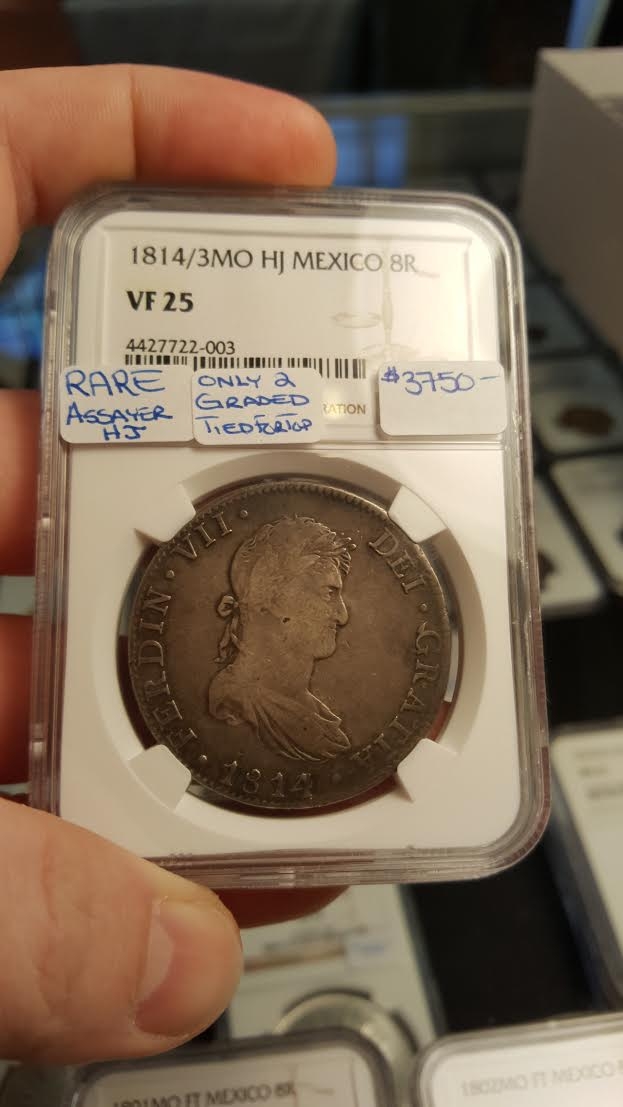
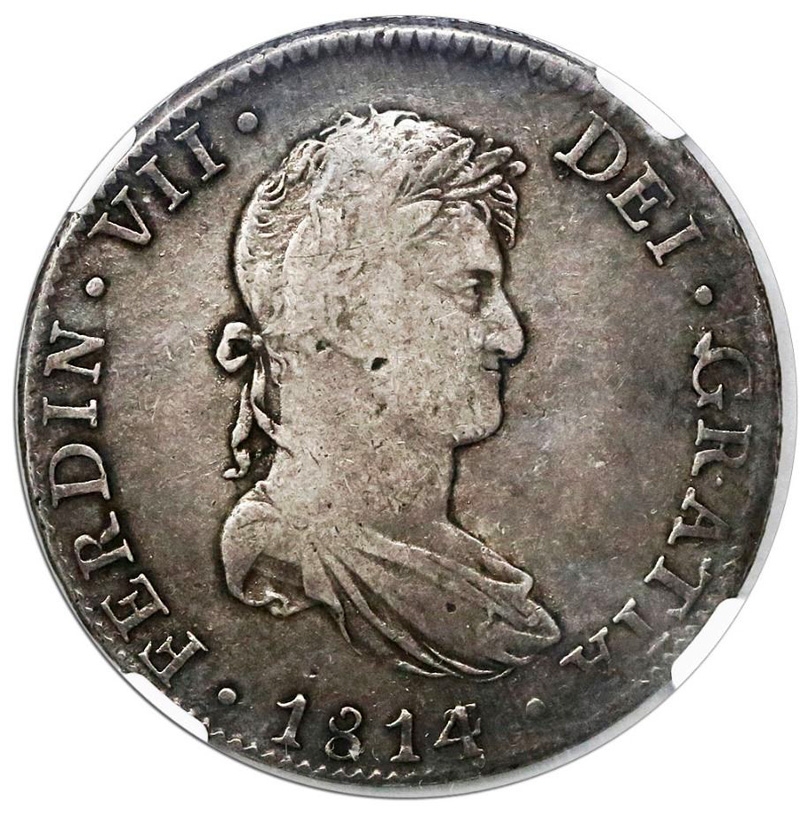
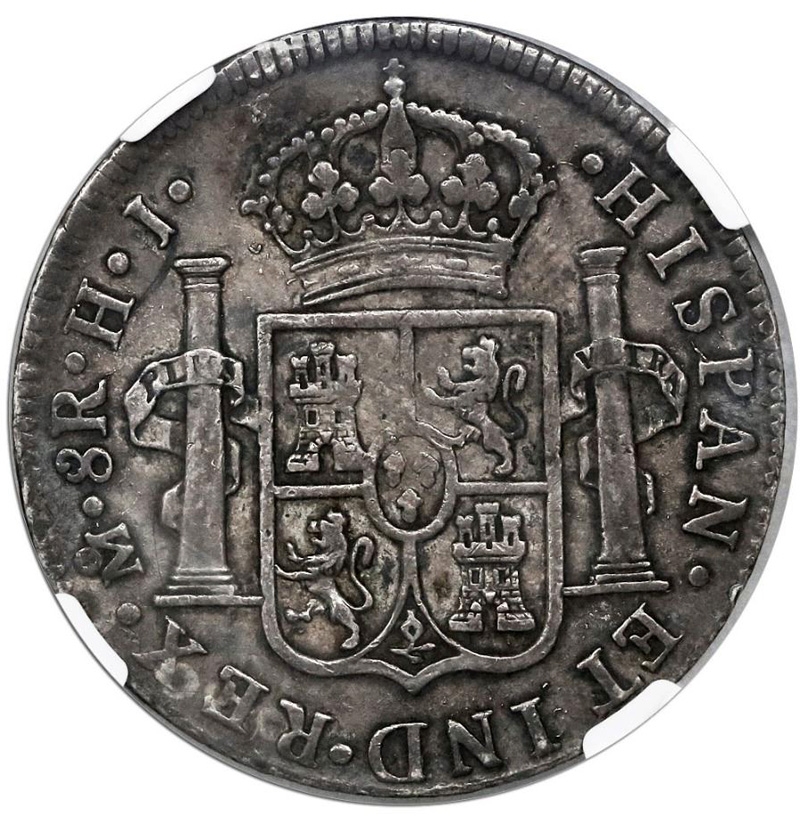
It's an 1814/3 Mexico 8 Reales. What makes it a very rare piece are the assayer initials HJ (Henrique B. Azorin + Joaquin Davila Madrid), instead of the common JJ (Joaquin Davila Madrid + Jose Garcia Ansaldo).
I hope the catalog images are accurate and it has that gray original skin. I'll post my own shots once it arrives.

Update December 15th
The coin is now in my hands and I'm very pleased with it. I was pretty nervous about Aureo pictures, having received quite a few cleaned pieces that looked problem-free in their auction catalog in the past. Looks like a nice XF40-VF35. Nothing is raising red flags in terms of authenticity. 26.78 grams and properly edged.
Overdate 4/3 is weak, but you can see it under magnification (see image below). Researching information about this coin I saw that Calbeto mentions an 1814 HJ without an overdate in his Compendium, but lacks a plate coin for it. I was not able to find a reference to it in any other material. All the information points to 1814 HJ
having a 4/3 overdate, which makes me wonder if the HJ die pair only had one obverse die, which was recut from the previous year. Since I've only been playing in this field for a few years, I'm hoping somebody more experienced can chime in on this.
Without having more examples of the 1814 year it's hard for me to put together a comprehensive picture of the dies used, but my assumption based on the scarcity of the different assayer combinations makes me think that it was somehing along the lines of the production starting with the recut 1814/3 die and HJ reverse. Shortly afterwards the HJ die was replaced with a JJ (are there any JJ/HJ coins out there?), keeping the same 1814/3 obverse die (going to see if I can find clear examples of this die to confirm it was the same one), then changing the 1814/3 to 1814 die.
Taking one more step back, what's with multiple assayers on Mexico City coins from 1812-1814? Both HJ(Henrique B. Azorin + Joaquin Davila Madrid) and JJ(Joaquin Davila Madrid + Jose Garcia Ansaldo) assayer initials can be found on coins of that period. And if you look at the Armored Bust series you see similar things happening with the TH and HJ assayers.
Looking at the Ferdinand VII coinage of 1808 to 1821 from Mexico City Mint we have:
1808 --- TH
1809 --- TH
1809 --- HJ/TH
1809 --- HJ
1809/8 --- TH
(possible there is 1809/8 HJ/TH?)
1810/09 --- HJ
1810 --- HJ/TH
1810 --- TH
1810 --- HJ
(what about 1810/09 HJ/TH?)
1811/0 --- HJ
1811 --- HJ
1811 --- HJ/TH
(what about 1811/0 HJ/TH?)
1812 --- HJ
1812 --- JJ/HJ
1812 --- JJ
(any overdates this year?)
1813 --- HJ
1813 --- JJ
(any overdates and over-assayers?)
1814/3 --- HJ <--- Last time HJ die is used
1814/3 --- JJ
1814 --- JJ
(was the HJ die recut? if so, are there JJ/HJ for both 1814/3 and 1814 obverse dies?)
1815/4 --- JJ
1815 --- JJ
1816/5 --- JJ
1816 --- JJ
1817 --- JJ
1818 --- JJ
1819 --- JJ
1820 --- JJ
1821 --- JJ
Very interesting series to study.
Almost forgot - here's the coin


I had to play with lighting and contrast to make the overdate obvious in the photos.

Update as of May 7th, 2017:
So, after the Sedwick sale, i followed-up with Kent Ponterio and we've settled on the price for another 1814/3-HJ they were selling as part of a large 8 Reales collection that I was able to preview at NYINC. Once the coin is back from Sedwick, it's going to be on its way to me.
Super excited to own two of these rarities.
First image is of the coin I snapped with my phone at NYINC, the other two are from the auction description.



1
Comments
Great pickup. I've had similar good luck on rarities this year. Could it be the economy or ...?
One thing I have noticed is that collectors of this kind of material only want the best. Maybe there is a nicer known specimen (of the ~5 known) and they are all waiting for it? Good luck to them, I say. Meanwhile you have a rare coin in great condition. (And for all I know, this could be the finest known.)
<< <i>¡Felicidades!
Great pickup. I've had similar good luck on rarities this year. Could it be the economy or ...?
One thing I have noticed is that collectors of this kind of material only want the best. Maybe there is a nicer known specimen (of the ~5 known) and they are all waiting for it? Good luck to them, I say. Meanwhile you have a rare coin in great condition. (And for all I know, this could be the finest known.) >>
Thank you, Stephen!
There are definitely bargains to be had, especially on material for sale in Europe. The economic uncertainty of the Euro Zone probably has something to do with it. When people get anxious about the future they either try to increase their short term cashflow by selling, or try and retain wealth by buying choice pieces that will hold value in the long run.
Did you participate in the Leunda sale? There were some nice War of Independence pieces offered. Did you see the 1810 Zacatecas? One of the best looking examples of that coin I've seen.
I am extremely disappointed with myself, because I had my eye on the 1813/2 Guadalajara 8 Reales they had and overslept the start of the live auction by 15 minutes (it was 5am EST), which was just long enough to miss the Guadalajara section and see it sell for about 1/4th of what I was willing to pay for it. *DOH* There was an 1815 I was planning to buy, as well. Not to mention the Chihuahua and Durango pieces that I also missed.
I also picked-up a 1789 Carolus IV (bust of Carolus III) for my type set.
How productive was your trip down South? Any newps to share?
8 Reales Madness Collection
<< <i>
<< <i>¡Felicidades!
Great pickup. I've had similar good luck on rarities this year. Could it be the economy or ...?
One thing I have noticed is that collectors of this kind of material only want the best. Maybe there is a nicer known specimen (of the ~5 known) and they are all waiting for it? Good luck to them, I say. Meanwhile you have a rare coin in great condition. (And for all I know, this could be the finest known.) >>
Thank you, Stephen!
There are definitely bargains to be had, especially on material for sale in Europe. The economic uncertainty of the Euro Zone probably has something to do with it. When people get anxious about the future they either try to increase their short term cashflow by selling, or try and retain wealth by buying choice pieces that will hold value in the long run.
Did you participate in the Leunda sale? There were some nice War of Independence pieces offered. Did you see the 1810 Zacatecas? One of the best looking examples of that coin I've seen.
I am extremely disappointed with myself, because I had my eye on the 1813/2 Guadalajara 8 Reales they had and overslept the start of the live auction by 15 minutes (it was 5am EST), which was just long enough to miss the Guadalajara section and see it sell for about 1/4th of what I was willing to pay for it. *DOH* There was an 1815 I was planning to buy, as well. Not to mention the Chihuahua and Durango pieces that I also missed.
I also picked-up a 1789 Carolus IV (bust of Carolus III) for my type set.
How productive was your trip down South? Any newps to share?
I am not particularly into War of Independence, Revolution, nor even Colonial issues. Sure, I have some in my collection, but I don't actively buy in these areas unless something speaks to me.
That said, I did pick up a very nice MS example of a 1R Proc (called a Jura in Mexico) in bronze, dated 1789 and issued to commemorate the enthronement of Charles IV. Grove catalog is C13a, but I can't figure out if the Krause number is Q24a or Q-A24a. I already have a beauty in silver, and a bronze, as you can imagine, is tough to get nice.
Sorry, I am photo-challenged at the moment.
The rest of my newps were Modern Mexico. Bimetallic errors, planchets, and possible patterns.
World Collection
British Collection
German States Collection
<< <i>That said, I did pick up a very nice MS example of a 1R Proc (called a Jura in Mexico) in bronze, dated 1789 and issued to commemorate the enthronement of Charles IV. Grove catalog is C13a, but I can't figure out if the Krause number is Q24a or Q-A24a. I already have a beauty in silver, and a bronze, as you can imagine, is tough to get nice. >>
That's one neat project! I've always been partial to the proclamation coinage of Latin America.
8 Reales Madness Collection
8 Reales Madness Collection
<< <i>where do we see the overdate? >>
Hmm, let me see if I can magnify.
8 Reales Madness Collection
8 Reales Madness Collection
<< <i>Original post updated. >>
When I handled a 1783 FM some time ago, I recalled this 1814 HJ variety (an example of each was sold in the Superior Sale of December 1990).
I wonder if the theory (which now seems to be the main accepted one) of these "mule" reverses with "old" assayer initials being used just because the volume of the production warranted or required it has any documental proof either factual or implicit (such as a document stating that assayer "H" had retired before 1814, making it impossible for his initial to appear then).
I am mentioning this because the assayer was one of the most important positions in the mint, and these errors would not have been treated lightly. Also worth mentioning is that for example the variety of the Chile Volcano 1817 Peso without assayer initials IS NOT the first one struck (supposedly the first dies had no assayer initials due to an omission), but the second one struck, and its die did not showing assayer initials was a deliberate action, since for a short period, the Santiago mint had no one to cover that position of assayer.
Congrats on a rare coin. :-)
Carlos Jara
http://www.lanumismatics.blogspot.com/
"A blog about Latin American Numismatics"
http://www.lanumismatics.blogspot.com/
"A blog about Latin American Numismatics"
<< <i>
<< <i>Original post updated. >>
When I handled a 1783 FM some time ago, I recalled this 1814 HJ variety (an example of each was sold in the Superior Sale of December 1990).
I wonder if the theory (which now seems to be the main accepted one) of these "mule" reverses with "old" assayer initials being used just because the volume of the production warranted or required it has any documental proof either factual or implicit (such as a document stating that assayer "H" had retired before 1814, making it impossible for his initial to appear then).
I am mentioning this because the assayer was one of the most important positions in the mint, and these errors would not have been treated lightly. Also worth mentioning is that for example the variety of the Chile Volcano 1817 Peso without assayer initials IS NOT the first one struck (supposedly the first dies had no assayer initials due to an omission), but the second one struck, and its die did not showing assayer initials was a deliberate action, since for a short period, the Santiago mint had no one to cover that position of assayer.
Congrats on a rare coin. :-)
Carlos Jara
http://www.lanumismatics.blogspot.com/
"A blog about Latin American Numismatics" >>
Carlos, thank you for your response.
I thought about the need to have the necessary volume produced as a possible explanation to why the old assayer dies were used, but it doesn't sit well with me for the same reasons you've talked about in your next paragraph - mint assayer was a prestigious position and I would be surprised if current assayers would allow the use of previous dies without having them re-cut.
I'm surprised that official mint records from that time are not available to put together an accurate timeline of the assayers.
8 Reales Madness Collection
Gary
I pulled my 1814 4/3 out to look at except mine is the common JJ instead of HJ
Experience the World through Numismatics...it's more than you can imagine.
<< <i>Looks like a nice XF40-VF35 >>
Talked to NGC today and they agreed with the VF35 grade. They also included the "Jose Leunda Collection" pedigree on the slab at no extra charge
8 Reales Madness Collection
Experience the World through Numismatics...it's more than you can imagine.
<< <i>Bumping this old thread. What a fantastic coin and fantastic story, well done. I did some of my own research and this coin is just unheard of. >>
Thanks, Dan. Great to see another collector taking interest in this series.
I actually crossed it into PCGS plastic at the same VF35 grade since then. I'm glad I dodged the "planchet flaw" bullet on this one.
8 Reales Madness Collection
I love the crudeness of these coins although it does make you wonder if this one is so rare because the whole lot of them were poorly made and thrown in the reject bin with only a few escaping the mint. For now we can only wonder.
8 Reales Madness Collection
8 Reales Madness Collection
Best,
Rory
Enjoyed numismatic conversations with Eric P. Newman, Dave Akers, Jules Reiver, David Davis, Russ Logan, John McCloskey, Kirk Gorman, W. David Perkins...
By the way, since this thread was originated, the fellow collector with the other example posted earlier joined PCGS and had the 1814/3 HJ graded, as well as some other beautiful examples from his life-long pursuit of colonials. You can see his sets by clicking here
8 Reales Madness Collection
I give away money. I collect money.
I don’t love money . I do love the Lord God.
Update in the original post...
8 Reales Madness Collection
Wowzers! Great finds of a super rarity. I like your newer one better...I can see the overdate without squinting (the squinting emoji, not the winking one
(the squinting emoji, not the winking one  )
)
Thanks, Cathy. The new one is definitely a later die state that shows the overdate and other die breaks much better, but still not showing the die crack through SP in "HISPAN" on the reverse (see the first coin below).
Here are some more images of the few other 1814/3-HJ's over the years:
2014 - Cayon Live Auction 21
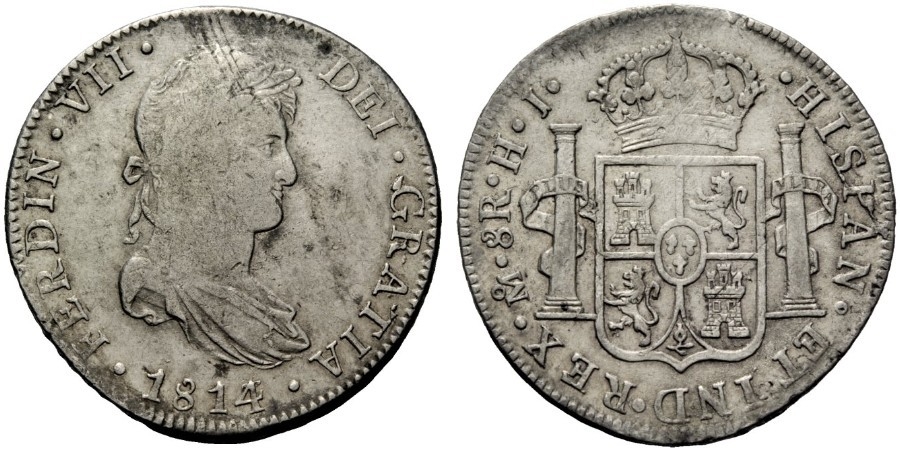

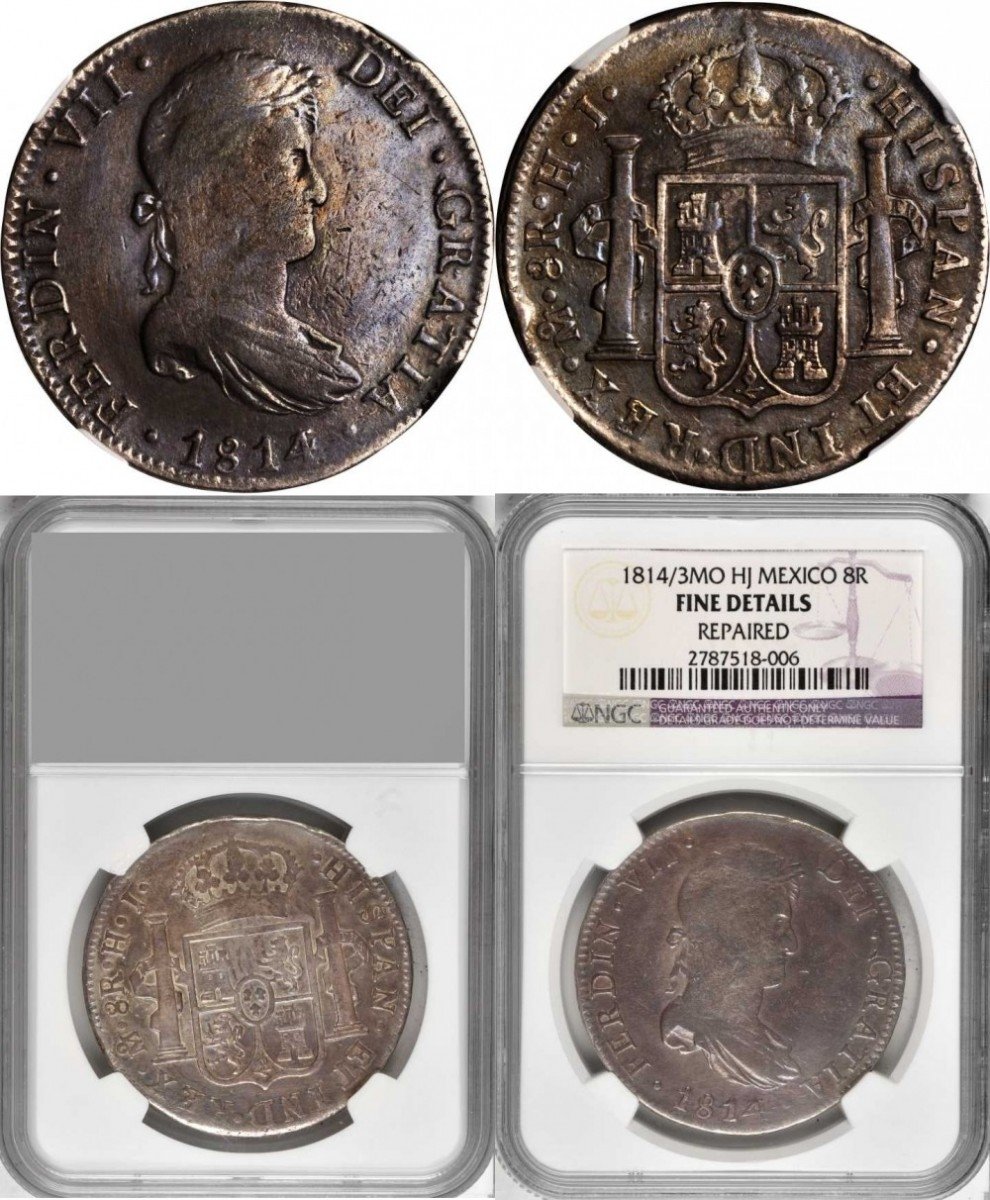
2015 - Aureo Auction 267
2015 - Stacks NYINC Auction
8 Reales Madness Collection
realeswatcher on another forum assembled a die progression for the reverse die crack and I added the one for the die chip near the G in "GRATIA"
8 Reales Madness Collection
Excellent!